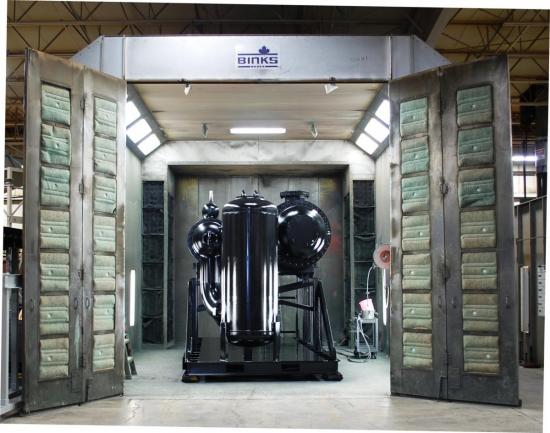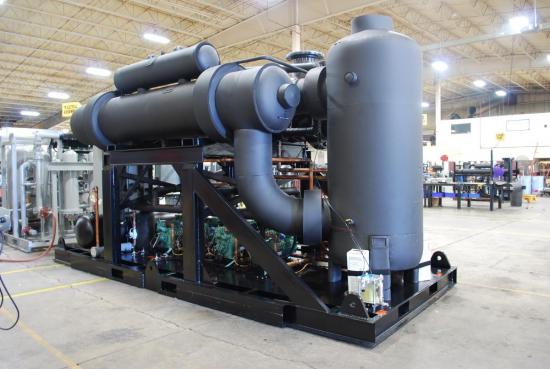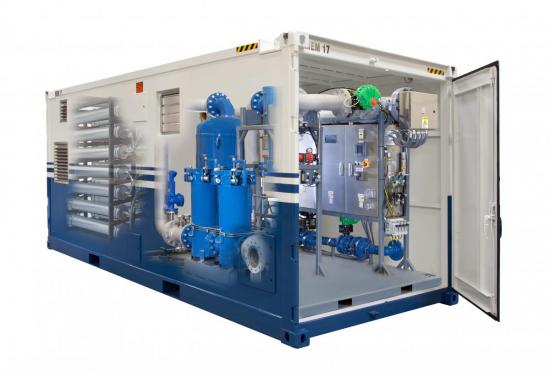Critical applications — such as semiconductor manufacturing, food processing and automobile spray finishing — require high quality, clean compressed air. Otherwise, those manufacturing facilities are doomed to costly rework, product recalls and a tarnished reputation._
“In semiconductor manufacturing, a small particle can ruin one of the die on a multi-die semiconductor wafer,” explained Dan Ryan, Engineering Manager, Parker Hannifin Corporation – Gas Separation and Filtration Division. “Even when it comes to things like painting automobiles, a few small, invisible particulates, depending on the makeup of them, can actually cause a visible flaw in the paint job.”
If you are in food processing, the stakes are even higher. Many of those plants need filtration beyond the compressor room. Often, air treatment and precise quality monitoring is required right at the point of use.
Given those market demands, Parker Hannifin recently consolidated several businesses under one umbrella — the Gas Separation and Filtration (GSF) division. The new business unit comprises Parker’s Finite Airtek Filtration (FAF) division, and the Filtration and Separation (FNS) division. With a portfolio of five brands (Airtek, Balston, domnick hunter, Finite, and Zander), along with custom-engineering capabilities, the GSF Division can address a comprehensive range of compressed air treatment and gas generation applications.

Freshly painted Magnum 20,000 scfm air dryer
“We’re pretty excited. We believe that putting these two divisions together gives us the whole portfolio,” said Scott Feenan, General Manager, Parker Hannifin – GSF Division. “From a customer’s perspective, we have the compressor room all the way down to the point of use covered — between dryer technologies, filtration technologies, and gas generation. There are not too many companies today that can offer that array of technologies as a one-stop shop for customers.”
To learn more about how Parker’s new GSF Division will impact industry, the team at Compressed Air Best Practices® Magazine spoke with three key GSF members: Dan Ryan, Engineering Manager; Scott Feenan, General Manager; and John Lucidi, Sales & Marketing Manager. During our discussions, we talked about how the logistics behind the consolidation will benefit Parker’s product portfolio, its distribution channels, and its end users.
Filter Manufacturing
With the reorganization, Parker FAF Division’s Finite filter manufacturing, based in Oxford, MI, and its FNS Division’s Balston filter manufacturing, based in Haverhill, MA, will be combined. The manufacturing processes from Oxford are physically moving to Haverhill, where the division will continue to manufacture both the Finite and the Balston brands of coalescing filters.
“There are some slight differences to the manufacturing methods between the way filters are made in Michigan and in Massachusetts,” Ryan explained. “After a little bit of an analysis, we determined that both manufacturing methods still have plenty of merit and have certain advantages. So we’ll still continue to make both Finite and Balston brands, and there will be a differentiation between the two.”
Understanding Different Coalescing Filters
High-efficiency coalescing filters are designed to remove oil aerosols and fine moisture droplets. They are also highly effective at removing particulates. Parker uses three different manufacturing techniques to make these filters.
“The basic design used today is sub-micronic glass. They incorporate glass fibers that have been manufactured so the average diameter of the individual fibers is at or below 1 micron,” Ryan told us. “Over the years, different materials have been added to the glass, for instance polymeric nanofibers, which are very small diameter plastic fibers added to the glass mix to improve efficiency. If you see an oil-removing coalescing filter, the construction is almost always micro-glass, but there are various ways to do it.”
One manufacturing method involves rolling filter paper. For this type of product, made early on by domnick hunter, filter paper is rolled four or five times, creating layers around a core. It is efficient because air is forced through a fairly thick section of micro-glass.
Another technique, commonly used by both the Finite and Balston brands, uses a vacuum formation process to manufacture a very similar finished product. During vacuum formation, micro-glass fibers are combined with chemicals called binders in a slurry of water. The vacuum then creates a cylindrical filter material that looks similar to rolled filter paper, but is actually only one layer of micro-glass — as opposed to the multi-layered rolled filter.
The third type of filter, which is now used for special applications by all Parker brands, is the pleated micro-glass filter. The pleating process typically takes one or more layers of filter paper, and puts them together in a pleating operation.
“Those are the three methods we employ, and all the brands still have variations of two of those particular types,” Ryan explained. “One is always pleated, and the other is either the rolled glass or the formed micro-glass. The vacuum-formed and rolled can be made to have a little bit higher filtration efficiency, but you sacrifice differential pressure. Pleated has extremely low differential pressure with very good efficiency for almost all applications.”
At the GSF division, Parker will manufacture pleated micro-glass coalescing filters for high flow and high inlet air concentrations. The main product, however, is the vacuum-formed filter elements, because they are cost effective and very efficient.
Combined Testing Capabilities
Another significant aspect of the new division is its testing capabilities, which will integrate testing labs from the Michigan and Massachusetts locations. The manufacturing plant in Oxford has been producing coalescing filters for close to 35 years, and its testing capabilities have grown over those years to include a fully equipped and fully staffed test laboratory. Used for both product testing and R&D, the testing facility ensures that Parker meets the quality claims about particulate removal and coalescing efficiency listed in its literature.
The Haverhill location has also developed a laboratory for testing to ISO 12500. During product development, engineers from both branches are able to use one another’s testing facilities for confirmation, providing a unique capability for substantiating engineering claims. Under the new consolidation, the Oxford lab will be moved to the Haverhill location.
“We’ll have the opportunity, unlike most of our competitors, to actually have two full sets of test equipment,” Ryan said. “It’s really important for us to make sure that what we say on the outside of the carton is exactly what the product does. There’s an ASME inspector who is in our facility in Lancaster three or four days a week. He’s got his own office in our building. That’s how serious we are about making sure we meet all the certifications that our customers demand.”
Filtration Testing: To What Standard and Why?
Frequently, facilities in the food processing and medical industries concern themselves with ISO 8573-1 purity classes, making sure their compressed air has safe and acceptable levels of particulates, water and oil. While air filters help end users reach certain quality classes, filter manufacturers are more concerned with ISO 12500, because it helps to test the efficacy, or efficiency, of the filter.
“If you read 8573 carefully, the rating is a measurement of the quality of the compressed air. When we manufacture a filter, we think more in terms of efficiency percentage,” Ryan explained. “If you have a filter that is 99 percent efficient, and the incoming air is very clean to start with, then the air that’s exiting is extremely clean to finish. So if you measure just according to ISO 8573-1, you don’t take into account the inlet conditions at the filter.”
The ISO 12500 series of standards actually calls out the levels of inlet contamination concentration, and manufacturers report on the level of outlet contamination. In that way, it becomes very easy to compare two different competitive filters, or even filters of two different technologies.
“If you want to measure the actual efficiency of the filter, you use ISO 12500. To specify air quality, you use ISO 8573,” Ryan stated. “The two standards are used hand in hand, and customers or end users who really understand what they’re doing need to have a little bit of knowledge about both of those standards.”
Compressed Air Dryers and Gas Generators
A third logistical maneuver taking place involves moving the Parker FNS Division’s industrial nitrogen generator manufacturing operation located in Baltimore, MD, to its “show-piece” facility in Lancaster, NY. The Lancaster plant manufactures cycling and non-cycling refrigerated dryers, and an exhaustive array of desiccant air dryers — many of which are customized and handled through their Special Engineering Group. The addition of nitrogen generators to Lancaster’s manufacturing operations makes sense based on similarities in technologies.

Magnum 27,000 scfm air dryer being staged for shipment to a large tire manufacturer
“From a manufacturing standpoint, we’ve taken the Baltimore industrial gas generation business and folded it into the Lancaster operations,” Feenan told us. “The large twin-tower systems that create nitrogen and oxygen gas are really similar technology to pressure swing adsorption (PSA) dryers. You have differences with overall system design, timing cycles and desiccant selection, however, if you saw a gas generator being built next to a PSA dryer, they’d look very similar.”
Now Lancaster will make both pressure swing adsorption dryers and nitrogen gas generators for its key markets. Parker also believes bringing the gas generation technology under the GSF umbrella will help broaden its distributors’ portfolios.
“We have a lot of tools that we can bring to a distributor,” Feenan said. “We do a lot of training with our selling system and distributors to make sure they are an application expert out in the field. Gas generation is relatively new, let’s say in the last 10 years, but it is very complementary to a compressed air distributor’s portfolio. They need this kind of assistance. It helps them be successful.”

6000 scfm blower purge desiccant dryer specifically designed for an oil refinery
In addition to industrial nitrogen gas generators, the FNS Division’s analytical laboratory gas generators will also be integrated into the GSF division’s product portfolio. Lab gas generators will continue to be manufactured at the Haverhill plant. The team at Parker believes that the FNS side of the business can bring its in-depth application knowledge to all aspects of the new GSF Division.
“We sell a great deal of lab gas generators into the life science market for gas chromatography and mass spectroscopy, and we have a really good understanding of that market,” Lucidi explained. “And that’s something the FAF side of the business has been getting into more — with medical air dryers and chillers for medical applications. We think there is an opportunity to share expertise across markets to better serve the customer.”
Broadening the Portfolio and Expanding Technical Expertise
There are many questions that arise when evaluating compressed air quality and gas generation: What levels of oil aerosols and other particulates are acceptable at the point of use? Where should I position filters, and how efficient should they be? Is it more cost effective for me to generate my own nitrogen? How do I achieve and monitor for sterile air?
Parker’s new GSF Division seeks to answer those questions — and countless others — by disseminating product and application expertise throughout its selling force and distribution network. The newly formed division will look to capture the specialized knowledge and skills from each division, and implement the best practices across the entire business unit.
“Superior sales skills and application advice — that’s what we are hoping to bring to the entire product line,” Lucidi told us. “We want to take the successful selling tools from the individual teams, and develop a sales organization that is knowledgeable and very well informed. One that supplies significant value and expertise to the customer.”
By following the strategic consolidation with an investment in the sales force, Parker’s new GSF Division is looking to better educate end users, and provide more value to them in the long run.

Containerized, high-pressure nitrogen generation system
“Now we’ll be able to supply the customer with the best of both worlds for compressed air filtration, dehydration and gas generation systems,” Feenan explained. “Parker Finite, Airtek, domnick hunter, Zander and Balston are some of the very best industrial compressed air and gas brands, and we intend to build on a reputation of engineering and application expertise to help support our distributor network.
“From an operational perspective, we’ll have Lancaster as a center of excellence for large-scale compressed air treatment and gas generation, and then we’ll have our Haverhill operation, which will be a center of excellence for vacuum-formed filter media, filter housings, and filter assemblies for point-of-use applications, or as pre- and post-filtration for large-scale dryers or gas generators. We believe that our newly merged capabilities will bring value to the marketplace.”
To read more about Compressed Air Treatment, please visit www.airbestpractices.com/technology/air-treatment.




